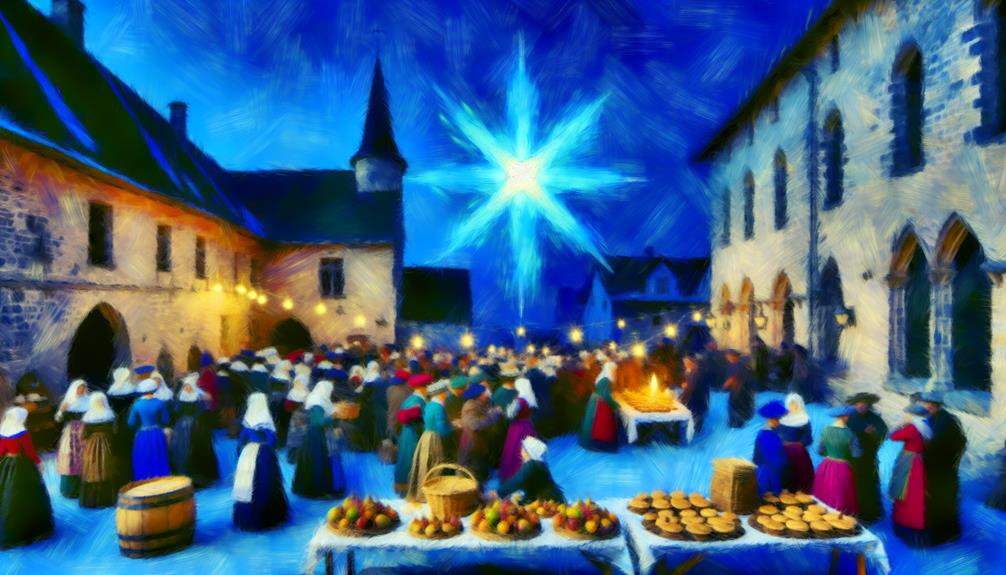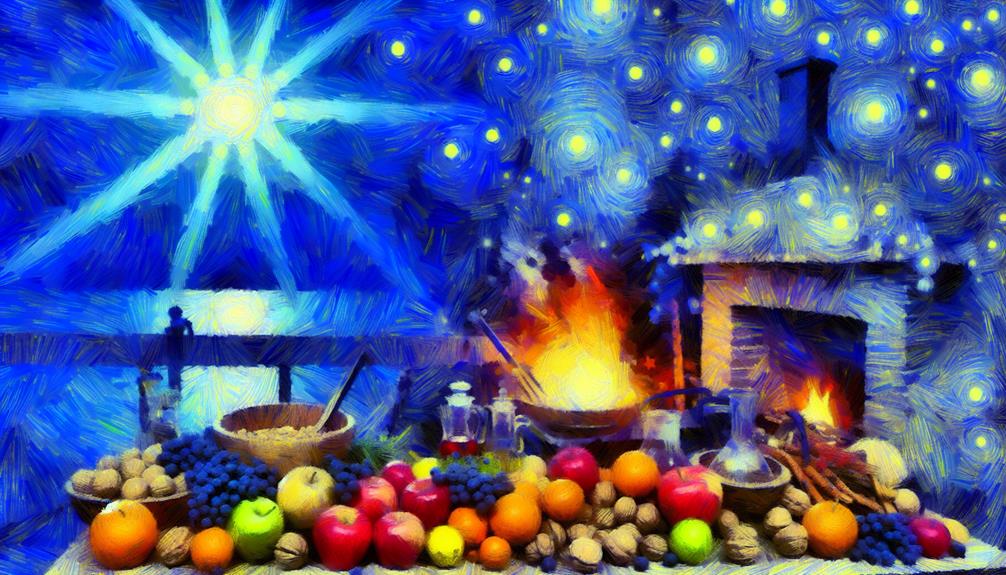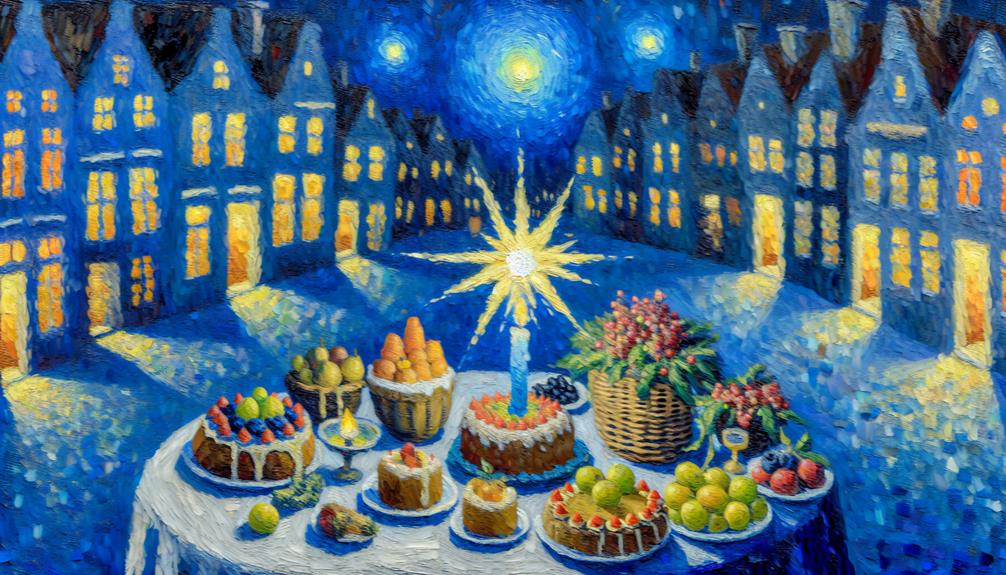Fruitcake is a delightful Christmas tradition with roots that stretch back to ancient Rome, where soldiers carried energy-packed bars made from honey, barley, and dried fruits. As centuries passed, this humble treat transformed, especially in the Middle Ages, when sugar and exotic spices turned it into a lavish delicacy. By Victorian times, it had become a luxurious gift symbolizing prosperity and joy. Today, the long preparation process, involving soaking fruits in spirits and months of maturing, adds to its rich, legendary flavor. Curious how this ancient energy bar transformed into a festive dessert shared around the world? There’s much more to discover!
Takeaways
- Fruitcake symbolizes prosperity and good luck, making it a traditional Christmas gift.
- The cake’s rich ingredients and long preparation time make it ideal for festive celebrations.
- Victorian England popularized fruitcake as a luxurious holiday treat and gift.
- Fruitcake’s longevity and flavors are enhanced through months of maturation and spirit-soaking.
Ancient Origins
The origins of fruitcake trace back to ancient Rome, where it began as a high-calorie energy bar known as satura, made from a mix of barley, honey, and dried fruits. This early version of fruitcake served practical purposes—it was nutritious, portable, and long-lasting, making it an ideal snack for Roman soldiers during their conquests.
As time marched forward, fruitcake saw significant changes, especially during the Middle Ages. This was a period when spices and preserved fruits were introduced to the mix, transforming the satura into a more luxurious delicacy. These new ingredients weren’t just for flavor; they were symbols of wealth and exoticism, making fruitcake a highly coveted holiday treat.
Imagine, in those days, biting into a slice of fruitcake was like tasting a bit of the world! The role of fruitcake as a holiday treat began to take shape as it became associated with special occasions and celebrations.
It’s fascinating to think how this humble energy bar evolved over centuries into a symbol of festivity and joy. It wasn’t just a treat; it was an experience imbued with the rich history and culture of the times.
Middle Ages Evolution

During the Middle Ages, fruitcake underwent significant transformations, becoming an even more indulgent treat.
With the introduction of sugar and exotic spices brought back by the Crusaders, medieval cooks crafted richer, more flavorful recipes.
This period also saw fruitcake becoming a staple at festive celebrations, symbolizing prosperity and joy during weddings and Christmas feasts.
Medieval Ingredient Innovations
In the Middle Ages, the evolution of fruitcake was profoundly influenced by the newfound accessibility to sugar, which enabled the preservation of fruits and the creation of richer, more sumptuous desserts. This newfound ingredient made it possible to preserve fruits by drying or candying them, laying the groundwork for the fruitcake in the entire medieval world.
Dried fruits became a staple, transforming simple bread-like cakes into luxurious treats. Incorporating these preserved fruits, along with spices and honey, created a dense, sweet dessert that was unlike anything people had tasted before.
This combination of rich ingredients turned fruitcake into a symbol of wealth and indulgence, making it a fixture in Holiday Traditions and special celebrations. The introduction of candied fruit, made by boiling fruit in sugar syrup, further enhanced its appeal and sweetness.
Crusaders’ Influence on Recipes
Returning from their expeditions, Crusaders introduced Europe to an array of exotic spices, dried fruits, and nuts from the Middle East, which fundamentally transformed fruitcake recipes.
Imagine the excitement of medieval bakers as they experimented with these new ingredients, infusing their cakes with flavors never before tasted in Europe. These additions made fruitcakes rich and dense, perfect for long preservation—an essential quality for soldiers and travelers of the time.
With the arrival of sugar, brought back by the Crusaders, fruitcake recipes took another leap forward.
Candied fruits became a staple, adding vibrant colors and intense sweetness to the mix. This transformation allowed fruitcakes to be not just a treat, but a decadent dessert reserved for special occasions.
Festive Celebratory Confections
As medieval bakers embraced the exotic ingredients brought back by the Crusaders, fruitcake evolved into a rich and festive treat, laden with dried fruits, nuts, and spices. This evolution marked a significant shift in how baked goods were perceived, transforming simple bread into a luxurious confection reserved for special occasions.
During the Middle Ages, the availability of ingredients like raisins, almonds, and cinnamon turned fruitcake into a sought-after delicacy. The introduction of sugar from European colonies in the 17th century further enhanced its appeal, allowing for the preservation of fruits, which added sweetness and longevity to the cake.
Holiday Celebrations: Fruitcake became synonymous with Christmas, symbolizing indulgence and prosperity during festive gatherings.
Weddings and Holidays: It was also a popular choice for weddings, symbolizing abundance and good fortune for the newlyweds.
Gifts: By the Victorian era, fruitcake was often given as a holiday gift, presented in decorative tins, making it a cherished part of holiday traditions.
Today, fruitcake remains a beloved part of Christmas celebrations worldwide, embodying a rich history of festivity and tradition that continues to bring joy and holiday cheer.
Cultural Significance

Fruitcake holds a unique cultural significance during Christmas, symbolizing prosperity and good luck across various traditions. In Victorian England, fruitcake emerged as a luxurious treat due to its expensive ingredients like candied fruits and alcohol. This decadent dessert quickly became a cherished Christmas gift, often exchanged among friends and family to symbolize goodwill and fortune.
The tradition of fruitcake during Christmas gained momentum through popular culture, particularly with the Christmas carol ‘We Wish You a Merry Christmas,’ which mentions the demand for figgy pudding, a close relative of fruitcake. As the song suggests, these rich, fruity desserts were integral to holiday celebrations, reflecting the festive spirit of the season.
When American colonists arrived, they brought the fruitcake tradition with them, embedding it deeply into holiday customs. Despite its mixed reputation, fruitcake remains a holiday staple in the U.S., with over 2 million sold annually. Its enduring popularity speaks to its cultural resonance as a symbol of celebration and endurance.
The historical significance of fruitcake as a special occasion dessert, originally designed for longevity, has solidified its place in Christmas traditions worldwide, making it a timeless emblem of holiday cheer and togetherness.
Ingredients and Preparation

When it comes to making a traditional fruitcake, the ingredients are as rich as the history itself. A mix of candied and dried fruits, nuts, and spices forms the base, often soaked in brandy or rum for added depth and preservation.
The process of preparing and maturing the cake, which can take several months, guarantees that the flavors meld beautifully, creating a festive treat that truly stands the test of time.
Traditional Fruitcake Ingredients
A quintessential holiday treat, traditional fruitcake is crafted using a rich assortment of candied and dried fruits, nuts, spices, and often spirits such as brandy, bourbon, or rum. These ingredients not only imbue the cake with deep, complex flavors but also contribute to its long shelf life. Fruitcakes are still beloved today, especially during the Christmas season, owing to their rich history and intricate preparation.
The foundation of a traditional fruitcake lies in its diverse array of candied fruit, which provides both sweetness and texture. Common selections include:
- Raisins and currants, which offer a chewy contrast.
- Cherries, often candied, adding vibrant color and a burst of sweetness.
Nuts such as almonds, walnuts, and pecans are frequently included, adding a satisfying crunch. The use of spices like cinnamon, nutmeg, and cloves gives the fruitcake its warm, festive aroma. Additionally, the inclusion of spirits not only enhances the taste but also acts as a preservative, allowing the cake to be enjoyed for months.
In essence, these ingredients come together to create a timeless dessert that is as enduring as it is delicious.
Preparation and Preservation Techniques
Crafting a traditional fruitcake involves meticulous preparation and time-honored preservation techniques that guarantee its rich flavors and extended shelf life.
The process begins with a delightful mix of candied and dried fruits, nuts, and spices, creating a dense, flavorful base. Ingredients like citrus peel, pineapples, plums, dates, pears, and cherries are often included, reflecting regional adaptations and adding a unique twist to each recipe.
Preparation for fruitcake doesn’t just stop at mixing ingredients. One important step involves soaking these fruits and nuts in spirits such as brandy, bourbon, or rum. This not only enriches the cake’s flavor but also acts as a preservation technique, allowing it to last much longer.
After baking, the cake is aged for at least three months, a period during which it is periodically brushed with more spirits. This careful attention to preservation techniques enhances both the flavor and texture of the fruitcake, making it a true holiday delight.
The combination of rich ingredients and these preservation techniques contributes to fruitcake’s legendary longevity. This is why fruitcake remains a cherished holiday treat, able to be enjoyed for months or even years after it’s made.
Modern Perceptions

Modern perceptions of fruitcake are mainly negative, despite its enduring tradition and cultural importance. This shift in sentiment can be traced back to the 1960s when comedian Johnny Carson famously joked that there is only one fruitcake in the world, and people keep sending it to each other. This quip solidified fruitcake as a holiday punchline, and its reputation has struggled to recover since.
Indeed, many modern perceptions of fruitcake are far from flattering. However, it’s essential to note that not all fruitcakes are created equal. Poorly made versions, often dry and overly sugary, have contributed greatly to the dessert’s bad reputation. Yet, there are artisanal fruitcakes crafted with care that retain the dessert’s historical richness and flavor.
Despite these mixed feelings, fruitcake continues to sell well, with over 2 million units sold annually in the U.S. This illustrates that while it may be a holiday joke to some, it remains a cherished tradition for others.
- Historical significance: Fruitcake symbolizes prosperity and good luck in various cultures.
- Quality matters: Poorly made fruitcakes have led to misconceptions.
Thus, fruitcake, despite its divisive status, endures as a festive staple.
Global Variations

While fruitcake may evoke mixed feelings in contemporary culture, its global variations reveal a rich fabric of traditions and flavors that continue to enchant holiday celebrations worldwide.
In Britain, fruit cake is often adorned with marzipan icing, creating a festive and sweet topping. The Caribbean offers a bold twist with its black cake, where fruits are soaked in rum for months, resulting in a rich, dense holiday treat that’s both flavorful and aromatic.
Italy’s contribution to the fruit cake family is the panettone, a light, sweet bread loaf filled with candied fruits, which has gained popularity far beyond its borders. Meanwhile, Germany celebrates with stollen, a traditional fruitcake packed with fruits, nuts, and spices, and typically dusted with powdered sugar, adding a snowy touch to the festive table.
Greece brings a unique twist with Vasilopita, a New Year’s cake that includes a hidden coin, symbolizing luck for the upcoming year. This tradition seamlessly blends the idea of fruitcake with local customs.
Down under in Australia, Christmas cake features a delightful mix of dried fruits and nuts, sometimes topped with icing or marzipan, making it a beloved holiday treat.
These global variations highlight the universal appeal and enduring charm of fruit cake.
Enduring Popularity

The enduring popularity of fruitcake can be attributed to its rich historical roots and cultural significance during the Christmas season. Originating from the 1700s and 1800s, fruitcakes became a symbol of luxury, with their sinfully rich ingredients like dried fruits, nuts, and spices. This association with indulgence made fruitcakes a cherished gift, especially during the festive season.
The tradition of giving fruitcake to carolers not only spread holiday cheer but also solidified its place in Christmas celebrations. As fruitcake gained popularity in America in the early 20th century, the convenience of mail-order fruitcakes in 1913 further integrated it into holiday traditions. Even today, over 2 million fruitcakes are sold annually in the United States, showcasing its lasting appeal.
Fruitcake’s cultural significance extends beyond its luxurious ingredients. It is often seen as a symbol of prosperity and good luck, which is why families keep passing it around during the holiday season. Despite its somewhat controversial reputation, the fruitcake remains a beloved Christmas staple.
- Represents prosperity and good luck
- Became popular in America through mail order
This timeless treat continues to bring joy and festivity to Christmas celebrations worldwide.
Frequently Asked Questions
Why Do We Have Fruitcake at Christmas?
Fruitcake is a Christmas tradition due to its historical association with festive celebrations, the use of luxurious ingredients, and its longstanding prevalence in holiday customs, particularly in England and later through mail-order availability in America.
What Does the Fruit Cake Symbolize?
Fruitcake symbolizes prosperity and good luck in various cultures. Its rich ingredients, once considered luxurious, represent generosity and festive spirit, making it a traditional celebratory food shared and enjoyed during extended holiday seasons.
What Is the Superstition About Fruit Cake?
The superstition surrounding fruitcake includes beliefs that receiving it brings good luck, baking and sharing it guarantees household fortune, and periodic feeding with spirits enhances flavor and longevity, with some even passed down generations for prosperity.
What Country Is Christmas Fruit Cake From?
Christmas fruit cake has origins in ancient Rome, but its modern form evolved in Europe, particularly in Germany and England during the Middle Ages. It is also widely enjoyed in Italy as panettone.
Conclusion
Fruit cake’s journey from ancient origins to a beloved Christmas tradition is fascinating.
With roots tracing back to Roman times, it evolved through the Middle Ages, gaining cultural significance.
The rich blend of ingredients and meticulous preparation reflect its celebratory nature.
Modern perceptions may vary, but its global variations showcase its enduring popularity.
Fruit cake continues to bring people together during the holiday season, symbolizing warmth, festivity, and the joy of shared traditions.













